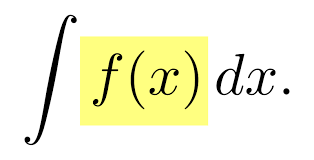Anti-differentiation + Integration
1/12
There's no tags or description
Looks like no tags are added yet.
Name | Mastery | Learn | Test | Matching | Spaced |
|---|
No study sessions yet.
13 Terms
How do you antidifferentiate
dy/dx = 20x4
∫20x4 dx
keep coefficient and x
add one to the power and divide by the new power
add +c
4x5 + c
Integrand

∫3Cos3x dx
Change Cos to corresponding
keep coefficient, keep angle
divide by the diff of the angle
add + c
Sin3x +c
∫2e2x dx
Keep everything
divide by the diff of the power
add a +c
When is the antidifferentiated function a log function?
when there is a fraction, with no x’s on the top and no x’s in the diff of the bottom
∫10/2x+7 dx
keep the top
muliplied by ln of the bottom
add a +c
all multiplied by 1 over the diff of the bottom
1/5.10.ln(5x-9) +c
What is speed?
ds/dt
the first derivative
What is acceleration?
d2s/dt2
the second derivative
What is integration?
area under a curve stopping at the axis
∫y dx when bringing it to the x axis
∫x dy
How do you integrate above the x-axis?
∫y dx
sub in y
integrate/differentiate y
put in limits to specify the area to be found
sub in the values of the limits
subtract the lower limit value subbed in from the higher limit value
How do you integrate above and below the x axis?
∫y dx
sub in y
integrate y
put in limits to specify the area to be found, integrate the above and below separately
sub in the values of the limits
subtract the lower limit value subbed in from the higher limit value
multiply the area under the x-axis by -1
add the areas together
How do you use Simpson’s Trapezoidal rule?
yn is the last height
yn-1 is the second last height
h is the distance between heights, and is a constant
sub in values to get approximate area
What is the formula for % error?
error(difference)/true value x 100/1 = % error